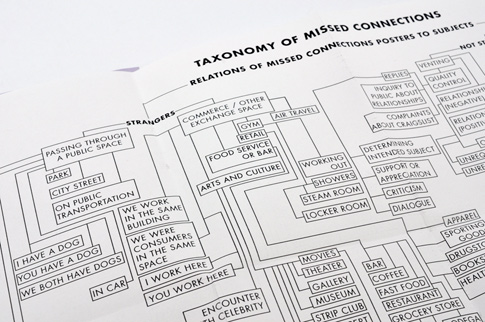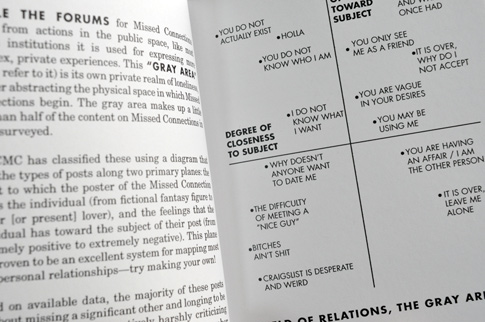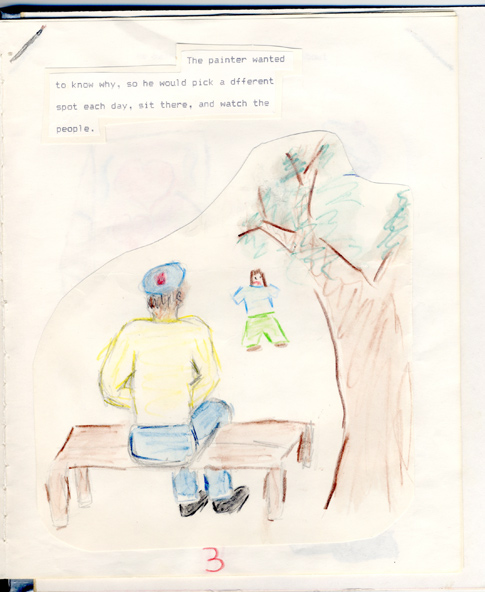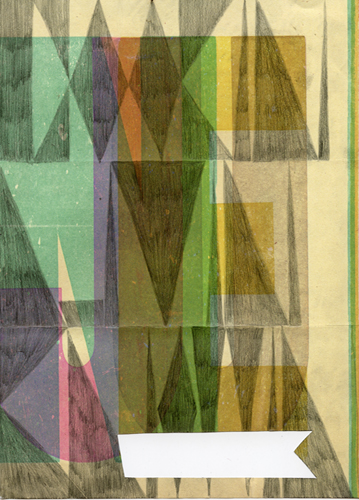If you live in a city, or even if you don’t, you have likely heard of and/or utilized Craigslist. From its humble beginnings, the website has grown to international proportions; used to place ads for jobs, housing, and those looking for human contact. Perhaps the most compelling aspect of the site is its category Missed Connections (MCs). Here, people post anything from one line to many paragraphs; seeking out those whose path they’ve crossed, people they’ve lost contact with, strangers they’ve seen in bars or cafes or streets that caught their attention. These posts reflect a desire to try and make real contact, when so much of our lives are spent surrounded by strangers, hours at work, or online. In the past year alone, these anonymous listings have inspired a book deal, blogs dedicated to the best of MCs, and artists’ work. Baltimore-based artist Ingrid Burrington has created a piece utilizing Missed Connections that is at once tongue-in-cheek and an adept response to the culture in which we live.

Using her “think tank initiative,” the Center For Missed Connections (CMC), Burrington examines MCs in five cities, charts their trends, and offers a work- booklet so that we might keep a log of our own missed connections as we go about our daily routine. Were someone to stumble upon her findings, one might imagine these graphs and worksheets to be yet another new dating device aimed at an increasingly lonely urban population. Rather, Burrington has created an untraditional piece of work that experiments with and questions our understanding of illusion and reality, blurring the two, while also offering an honest commentary on this phenomenon of communal loneliness and need for human connection in our country. This “outreach initiative” provides a critique of the way in which we communicate, date, relate, and experience loneliness and one another:
“You are in the world, in a city, somewhere crowded and vibrant, full of people. And you are alert with an awareness tempered by the wonderful, unspeakable loneliness of being among strangers… Missed Connections are the embodiment of one of the major lures of cities and urban centers: they are a temporary engagement with a total stranger in uncertain, finite intimacy.”
Burrington takes a humorous look at what constitutes a missed connection, its various forms, and how one may make their post most successful. Various categories of what she deems the “gray area” include, “holla,” “bitches ain’t shit,” and “why doesn’t anyone want to date me.” It’s this superficial cheekiness that cushions the subtext of her work. Rather than beat her audience over the head with the kind of heavy-handedness one might find in some artists’ whose work deals with social commentary; Burrington’s take is comical, relatable, and an astute critique of the way in which our culture often chooses to interact with one another.
Many of Burrington’s projects take things that are mundane- date books, puzzles, and rulers to name a few- and recontextualize them; endowing everyday objects with cultural substance and social critique. Her work is often collaborative, and text appears in nearly every piece. Some take the form of pamphlets and index cards, while others are protest signs or banners that demand “milk & cookies!” or “revolution can be avoided.”
 what do we want? NOW! when do we want it? NOW! . Ingrid Burrington and Matt Bettine 2008.
what do we want? NOW! when do we want it? NOW! . Ingrid Burrington and Matt Bettine 2008.
Her work offers a means of resistance to traditional artistic genres, as well as to our current culture and what is valued. In “Tips for experiencing a missed connection,” Burrington advises her reader how to go about becoming an MC. Among them, the artist suggests you: be attractive; identify which an adjective (cute, hot, sexy, etc) that best suits you and try to embody it; leave before any actual contact can be made; and start living. How very apropos that in trying to really live, we abandon actual interaction and possibility in favor of an online fantasy. It is here, and in other pieces, that Burrington subtly dismantles socially constituted norms and brings them into question.
Burrington manages to avoid heavy handedness as she maps the world of MCs. Rather than create a piece that mocks those who flock to Missed Connections in lieu of real human contact, the artist offers us a thoughtful, rather blithe take on the palpable loneliness that seems to proliferate so many of these posts. Between Match.com, OkCupid, eHarmony, and myriad other dating sites, it’s no surprise that we (the collective we) have become disconnected.
If such sites weren’t to exist, would we still feel the same lack of connectedness? It seems that in attempting to quell the feeling of loneliness and isolation, dating sites may compound the feeling; allowing people to search for others at their leisure and in the comfort of their home. Rather than step out into the world where rejection is a real possibility, those who date online only have to face a virtual one, and can quickly move on to the next profile. CMC is a critical look at this delusional approach to interaction, and acknowledges the irony in our attempts to establish contact via Missed Connections with those we wish to engage in reality, but actively choose not to.
 Taxonomy of Missed Connections, detail. In the Center for Missed Connections Citizen’s Field Guide, Center for Missed Connections Information Initiative, 2010
Taxonomy of Missed Connections, detail. In the Center for Missed Connections Citizen’s Field Guide, Center for Missed Connections Information Initiative, 2010
In CMC, we are given statistics, pie charts, and insights into the workings of each city’s MCs. It’s in this urban sea of strangers that we make a connection, and perhaps we find comfort in this collected loneliness. In CMC and other pieces, the artist dares the viewer to ignore this current state of detachment in which we seem to exist. As Burrington navigates the world of interreality through various non-traditional formats, she manages to create works of art that are simultaneously provocative, critical, and humorous; and through them we are given a glimpse at how our culture has dissociated, as well as our genuine desire to find a connection amidst this often self-imposed isolation.
.
.
.
Madeleine Zinn is a writer and erstwhile artist based in Oakland. Her main interests include non-fiction, community arts, pop culture, and queer theory and identity politics. She is currently pursuing a dual MFA/MA in Writing and Visual & Critical Studies at California College of the Arts.


 what do we want? NOW! when do we want it? NOW! . Ingrid Burrington and Matt Bettine 2008.
what do we want? NOW! when do we want it? NOW! . Ingrid Burrington and Matt Bettine 2008. Taxonomy of Missed Connections, detail. In the Center for Missed Connections Citizen’s Field Guide, Center for Missed Connections Information Initiative, 2010
Taxonomy of Missed Connections, detail. In the Center for Missed Connections Citizen’s Field Guide, Center for Missed Connections Information Initiative, 2010




 Matthew Cella, “Map 1024,” 48″ x 72″ UV print on brushed aluminum
Matthew Cella, “Map 1024,” 48″ x 72″ UV print on brushed aluminum







 My newphew on Christmas morning, patiently waiting for his one last present (a bike!) to be brought out. I love the patience and pleasurable anticipation on his face. That’s what the 2000′s sort of felt like to me.
My newphew on Christmas morning, patiently waiting for his one last present (a bike!) to be brought out. I love the patience and pleasurable anticipation on his face. That’s what the 2000′s sort of felt like to me.








